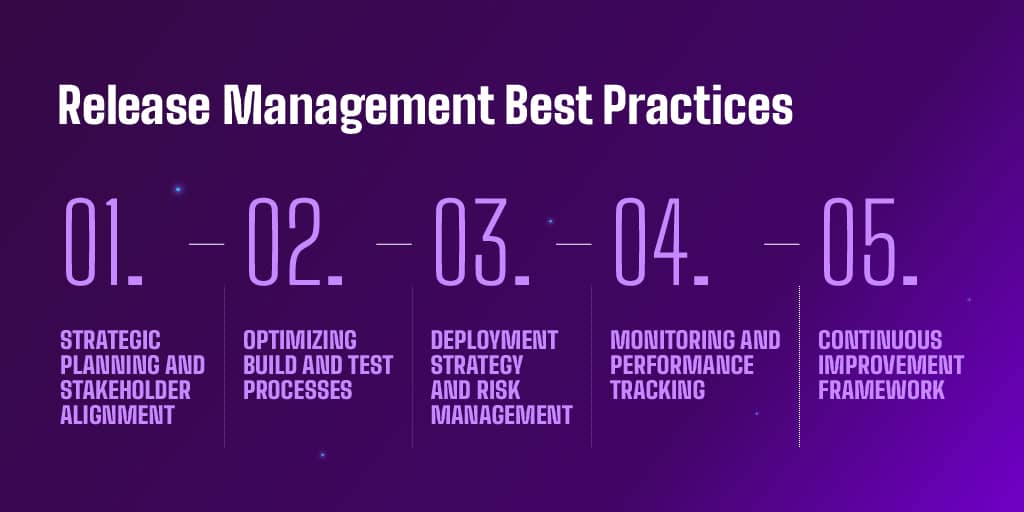Key Highlights
- Learn Release Management Best Practices to transform software delivery with efficiency
- Understand how strategic planning helps align stakeholders
- Speed up deployments with optimized build processes
- Get proven risk management strategies to deploy safely
When I started my career 15 years ago, things were quite different. As we mentioned in our Release Management essential guide, release management wasn't always as structured as today It grew from basic manual processes into more sophisticated systems as software development became more complex. Back then, releases were less frequent and involved fewer steps.
Back then deployments were often tension-filled events with manual processes and frequent issues. I've witnessed firsthand how both technologies and processes have evolved, transforming what was once chaotic into something more structured and reliable. An important distinction I learned along the way is that Deployment is about setting up the software in the correct environment and technically ensuring it is ready to be used. While the release is about making it available to end-users.
Through turning countless development challenges into success stories (and yes, I've weathered my share of failures), I've gathered proven practices that truly work. Every deployment crisis and release hiccup taught me valuable lessons, which I've distilled into 5 dimensions. Let's explore these insights to help you establish a robust release management process that reflects today's standards.

Release Management Best Practices
The 5 Essential Release Management Best Practices
1. Strategic Planning and Stakeholder Alignment
Coordinating effectively among different teams and stakeholders is one of the biggest challenges we face in release management. Poor strategic planning can trigger a cascade of issues that undermine the entire release process. You may have worked, or are working, in organizations that often struggle with misaligned expectations, ineffective communication channels, and inconsistent documentation. All of this leads to delayed releases and team frustration.
These challenges typically appear as missed deadlines, shifting schedules, teams with conflicting priorities, and undocumented requirement changes. The problems become especially apparent when departments work in isolation, creating information gaps and outdated documentation.
To address these challenges effectively, follow successful organizations' Release Management Best Practices:
- Create detailed release specifications with measurable success criteria that align with business objectives
- Establish early stakeholder engagement protocols to ensure all voices are heard from the beginning
- Maintain comprehensive documentation of requirements and decisions in a centralized location
- Implement transparent release calendars that all teams can access and understand
- Set up effective communication channels that facilitate quick decision-making and information sharing
After establishing strong strategic planning and stakeholder alignment, you must optimize your build and test processes to achieve release management excellence. Efficient processes in these areas lead to improved workflows and better quality.
Learn how Release Dashboards will help you master your communication.
Learn how Release Dashboards will help you master your communication.
2. Optimizing Build and Test Processes
You know that maintaining efficient build and test processes is one of the biggest challenges in modern software development. As your codebases grow more complex and teams expand, you might struggle with slow builds, inconsistent test results, and integration issues that only become apparent late in development.
Common issues include frequent build failures that take hours to resolve, bottlenecks from manual testing procedures, inconsistent test results across environments, and integration problems that surface only in late-stage development. These combined challenges significantly reduce your team's productivity and cause release delays.
Here are the key Release Management Best Practices you should implement to address these challenges:
- Implement automated build processes with parallel execution capabilities and caching mechanisms to reduce build times
- Establish comprehensive test automation frameworks that cover unit, integration, and end-to-end testing scenarios
- Maintain consistent development and testing environments using infrastructure as code and containerization
- Use continuous integration tools effectively to catch issues early and ensure code quality
With optimized build and test processes, the next critical step is to establish a robust deployment strategy and comprehensive risk management framework to ensure smooth and reliable releases.
3. Deployment Strategy and Risk Management
I've seen countless frustrated clients when their services went down during deployments. These incidents not only disrupt business operations but also damage customer trust. Having witnessed the impact firsthand, Robust deployment strategies and thorough risk management are fundamental to success.
Common deployment challenges include systems going offline during peak hours, mismatched configurations between environments, inadequate rollback procedures, and poor documentation. If you’ve been there, you know these issues leave teams struggling during critical deployments. When failures occur, your team must scramble to restore services without clear procedures or backup plans. This reactive approach leads to extended downtime, frustrated stakeholders, and increased operational risks.
The evidence of deployment management problems typically appears as:
Your team faces frequent deployment failures requiring immediate rollbacks, with unexpected system outages during release windows. Deployment documentation becomes outdated or missing, while inadequate monitoring leaves teams unaware of potential issues until they affect users.
Here are recommended Release Management Best Practices you should follow to mitigate risks and ensure successful deployments:
- Establish automated deployment pipelines with built-in validation checks and automated rollback capabilities
- Implement blue-green deployments and canary releases to minimize risk and impact on users
- Maintain up-to-date runbooks and disaster recovery procedures, regularly tested through simulated scenarios
- Deploy comprehensive monitoring solutions that provide real-time visibility into system health and performance metrics
Having established a solid deployment strategy, the next critical focus is monitoring and performance tracking—ensuring ongoing system reliability and swift resolution of any post-deployment issues.
4. Monitoring and Performance Tracking
You've likely experienced the challenges of monitoring and performance tracking, even with robust deployment strategies in place. Think about those times when performance issues went unnoticed until customers started complaining, or when your system slowed down during peak business hours without any early warning signs.
Through integration of Jira Service Management with monitoring tools, you can track and respond to incidents more efficiently, avoiding those costly oversights. That’s one reason Jira is a strong choice for release management: it brings issue tracking and project coordination together, so you can handle even complex releases with confidence. It helps you plan, stay on top of progress, and keep everyone aligned, with each person clear on their responsibilities.
You might recognize poor monitoring through several signs: outages are discovered through customer complaints instead of system alerts, performance issues go unnoticed, data stays scattered across disconnected tools, and it's difficult to correlate system changes with new deployments. This reactive approach leads to extended downtime, customer dissatisfaction, and missed opportunities for proactive problem prevention.
To build effective monitoring and performance tracking, follow these practices:
- Deploy comprehensive monitoring solutions that cover both technical metrics and business KPIs, integrated with Jira for incident management
- Set up intelligent alerting systems with appropriate thresholds and escalation paths through Jira automation rules
- Create dedicated feedback channels for both internal teams and end-users, using Jira Service Management portals
- Implement real-time analytics dashboards for tracking performance trends and release impacts, with Jira dashboards providing a centralized view
Now that monitoring and performance tracking are in place to ensure system stability, the final step is establishing a continuous improvement framework, one that promotes long-term growth and adaptability in your Release Management Best Practices.
5. Continuous Improvement Framework
You might be experiencing challenges maintaining momentum in your continuous improvement initiatives. What starts as an enthusiastic effort can become a stagnant process, where your team reverts to old habits and resists change. This pattern often emerges when examining Release Management Best Practices over multiple cycles.
Watch for these warning signs in your process: recurring problems keep popping up without lasting solutions. Retrospective meetings start losing engagement, with people treating them more like formalities than opportunities for improvement. Documentation sits outdated and unused. And perhaps most concerning, there's resistance to process changes, with a preference for the familiar, even when it's inefficient.
These signs indicate a fundamental issue: you lack a structured approach to continuous improvement that keeps your team engaged and motivated while delivering measurable results. Without addressing this, you risk falling behind competitors and losing your edge in delivery capabilities.
To build an effective continuous improvement framework and address these challenges, you can follow these key practices:
- Conduct regular post-release reviews with structured agendas and clear action items
- Document lessons learned in an accessible and searchable knowledge base
- Update processes based on quantifiable performance metrics and team feedback
- Implement systematic feedback loops that ensure process improvements are adopted and measured
Conclusion
These five dimensions will make your software delivery more effective. Adding clear communication, automation, monitoring, and improvement practices to the process delivers real results. Your teams will release software more reliably and maintain high-quality standards. You'll also reduce common problems like failed deployments and system issues. Start using these practices today to make software delivery more efficient. Each improvement you make will help build a better release process.
Key Takeaways
- Align stakeholders early and maintain centralized documentation for effective communication.
- Automate build, test, and deployment processes to reduce errors and improve efficiency.
- Implement comprehensive monitoring systems to detect and address performance issues proactively.
- Conduct post-release reviews and document lessons learned to drive continuous improvement.
Transform your Test Environment Management with Apwide Golive:
Leading companies have already Golive as part of their DevOps toolchain:





Free trial / Free forever up to 10 Jira Cloud users!


